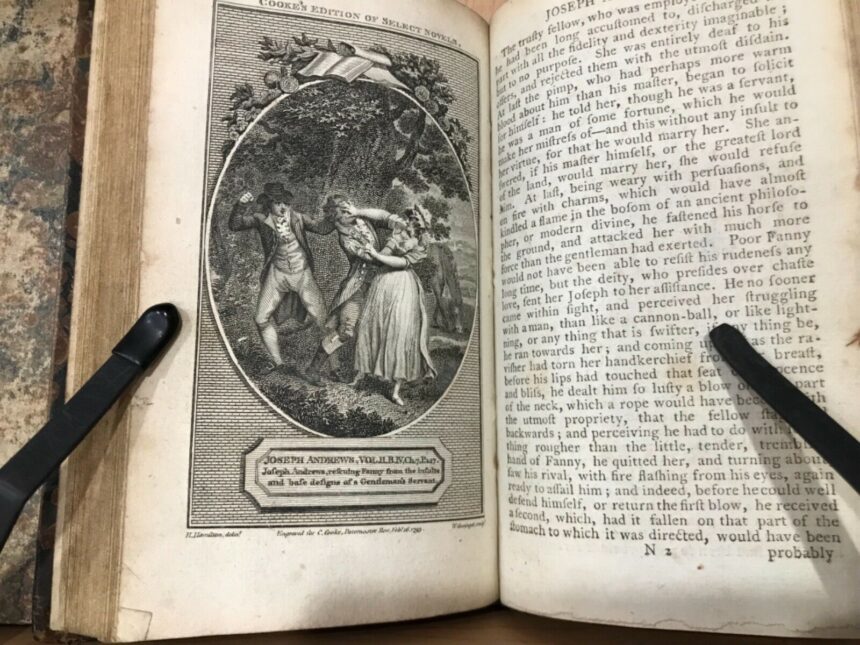Picaresque novels are genres of fiction that feature frequent mishaps, brawls and quarrels. The plotlines tend to be loose with plenty of slapstick comedy throughout, usually featuring characters from lower social classes.
Henry Fielding’s Joseph Andrews follows a young footman and his friend Parson Adams as they journey from London to their home in the countryside. Along the way, they encounter robbers, rude inn owners, sexual temptations and false kindness from upper class people while maintaining their Christian virtue and charity.
Characteristics of a Picaresque
The picaresque novel is a genre of fiction featuring an irreverent hero who struggles to survive in an oppressive society. It may also contain elements of satire.
This genre of prose fiction often takes the first person narrative approach as an autobiography and deals with themes such as life, morality, integrity and social stability.
Picaresque novels typically revolve around a rogue hero of low birth who belongs to the lower classes in society. This hero is commonly referred to as a picaro – an adjective meaning “adventurer, rogue” or scavenger.”
At its inception, the genre was mostly associated with Spain; however, it can now be found across Latin America and to a lesser degree England and America as well. Toward the end of the 20th century however, more literary critics – even those who hadn’t previously given much consideration to it – began appreciating its importance.
The first picaresque was published anonymously in 1554 in Burgos and Medina del Campo in Spain and Antwerp in 1612; later works such as Hans Jakob Christoffel von Grimmelshausen’s The Adventurous Simplicissimus (1912) and Mark Twain’s Adventures of Huckleberry Finn (1884) showcased a more mature form. While this genre had its heyday in Europe, it was revived during the nineteenth and twentieth centuries in America via dark humor.
Picaresque novels are distinguished by a series of thrilling events connected by the central character. The plotline is episodic, with insider knowledge providing thrilling or sensational experiences for readers; plus there is great variety in social setting as well as incident and character types. While novelists may satirize certain character flaws or corruption within society, their primary goal remains to entertain readers while providing them with an entertaining read.
Another characteristic of the genre is that the protagonist typically lacks moral character traits but instead portrays themselves as carefree rascals who usually refrain from criminality. Their actions may be motivated by money or fame but lack moral obligation; in some cases, they might even be hypocrites who disregard other people’s needs.
Other characteristics that define a picaresque genre include irony, use of satire and humor, as well as realism. In many cases, the genre takes place in an anti-romantic society where traditional values are crumbling away.
Picaresque novels often include interpolated narratives and letters that extend the timeframe into earlier times, yet their primary aim remains to satirize a corrupt society; therefore, authors rarely attempt to place their story in any other era.
Characteristics of a Picaro
The picaresque is an art form that originated in sixteenth-century Spain and has since spread throughout Europe. It follows the exploits of a hero (picaro), usually an outcast or troublemaker. Additionally, picaresque novels often contain satire or comedic elements as well as critical views on social or moral issues.
In the nineteenth century, this genre of fiction rose to popularity as a reaction against romantic, courtly, and chivalric genres of literature. Due to the breakdown of feudal society and decline of aristocracy during this period, lower classes had no choice but to utilize unconventional means for survival.
Characters who tell their stories in the first person often expose hypocrisy and deceit within their society. For instance, Huckleberry Finn’s protagonist challenges racist attitudes within his own country as well as the inherent hypocrisy found within most societies.
One hallmark of the picaro is his inner struggle to make sense of an incomprehensible world. This is one reason why many people gravitate towards this genre – they get to view things through the eyes of someone from lower classes who doesn’t fit into society’s mold.
Picaresque novels often feature heroes living on the fringes of society, such as rogues or thieves. He may come from a low social class or have an illegitimate past. In the best examples of this genre, however, the hero is able to navigate the world with his wits and even become successful in some cases.
However, the picaro often comes from a low social class or is an outlaw, and may come from an impoverished family. His innocent and childlike personality often draws in readers who feel compelled to pity him.
He may be a rogue or criminal, and even a renaissance scholar. Most importantly, however, is his inherent morality which serves as an inspiring role model for others who wish to follow in his footsteps.
A picaro is usually from a low class or is an entrepreneur; he may also hail from an illegitimate family and come from either poor or abusive circumstances. They possess an innocent, childish, and nave outlook on life that makes them attractive targets for criminals and others alike.
People often gravitate toward this genre because it allows readers to view life through the eyes of a nave or childlike character who does not fit into normal social status or privileges.
For instance, the protagonist of The Adventures Of Huckleberry Finn is naive or childlike in nature and exposes both hypocrisy in his country and those around him. This makes the protagonist such an engaging symbol – a representation of what life as a picaro must be like and why readers find them so captivating.
Recommended readings:



















